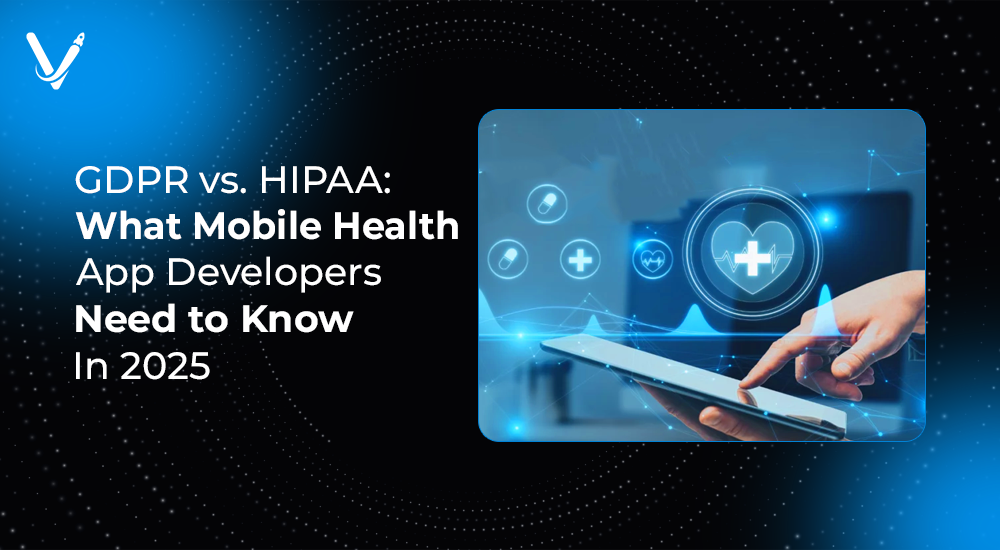GDPR vs. HIPAA: What Mobile Health App Developers Need to Know in 2025


- May 1, 2025



In the booming digital health industry, mobile health apps are reshaping how individuals manage wellness and chronic conditions. Developers today must juggle technological innovation with strict data protection laws that differ by region. Two pillars of health data privacy stand out—GDPR in the European Union and HIPAA in the United States. Understanding the key differences, overlaps, and implications of these regulations is essential for building secure, compliant, and trustworthy healthcare applications.
As user data becomes more sensitive and regulated, app developers face increasing legal and ethical scrutiny. Data breaches in health apps not only erode trust but can incur fines that cripple startups or stall enterprise innovation. Ensuring compliance with data protection laws is more than a checkbox—it defines user experience, determines app longevity, and shapes brand reputation.
Healthcare app development demands strong privacy frameworks to retain user trust. Consumers are increasingly savvy about their digital rights, and regulators are quicker to penalize negligence. The debate of GDPR vs HIPAA sits at the core of healthcare app development in 2025. Developers building solutions for both European and American markets must navigate dual frameworks without compromising security or usability.
Non-compliance can have devastating consequences beyond fines. In an era where privacy scandals frequently dominate headlines, public exposure can lead to irreversible brand damage. Thus, understanding both GDPR and HIPAA is not only about staying within legal boundaries; it is also about creating ethical, user-centered health technologies.
The General Data Protection Regulation (GDPR) is the EU’s sweeping framework for protecting personal data. Introduced in 2018, it redefined user consent, data portability, and accountability. GDPR applies to any organization processing the data of EU citizens, regardless of the company’s location.
For mobile health app developers, GDPR means that every touchpoint with a European user must respect specific rights and principles.
These principles guide the development and operations lifecycle of mobile health apps that handle sensitive personal information.
For mobile health apps, this translates into:
GDPR's emphasis on explicit consent and user empowerment demands careful UX and legal design in healthcare app development.
The Health Insurance Portability and Accountability Act (HIPAA) governs the use and disclosure of Protected Health Information (PHI) in the United States. While initially enacted in 1996, its significance for digital health surged with the HITECH Act in 2009, which extended compliance requirements to electronic systems.
HIPAA sets national standards to safeguard PHI, covering any individually identifiable health information held or transmitted by a covered entity or its business associate. Mobile health apps must adhere to HIPAA if they manage PHI on behalf of covered entities.
HIPAA applies to:
If your app stores patient information, sends appointment reminders on behalf of a hospital, or integrates with EHR systems, HIPAA compliance becomes mandatory.
HIPAA compliance is not static. Ongoing risk assessments, policy updates, and staff training are integral to a HIPAA-compliant operation.
Although GDPR and HIPAA were developed independently and for different jurisdictions, they share fundamental goals regarding the protection of sensitive personal data. Understanding the correlation between GDPR and HIPAA is crucial for healthcare app developers targeting both markets.
However, the scope, consent models, and enforcement mechanisms differ significantly.
Aspect | GDPR | HIPAA |
Scope | All personal data | Health-related personal data (PHI) |
Territorial Reach | Global (if dealing with EU citizens) | Primarily US-based |
Consent | Explicit and informed | Often implied for treatment purposes |
Enforcement | EU Data Protection Authorities | US Department of Health and Human Services |
Penalties | Up to 20 million Euros or 4% of global revenue | Up to $1.5 million/year/type of violation |
This matrix illustrates why dual compliance strategies are essential when developing international mobile health apps.
Developing a compliant mobile health app is challenging without technological support. HIPAA compliance software offers powerful solutions for:
Choosing the right compliance platform can significantly reduce overhead, improve security, and demonstrate due diligence in case of audits.
Many HIPAA compliance software tools in 2025 will integrate seamlessly with mobile app development services and frameworks, making it easier for startups and enterprises to focus on innovation while ensuring regulatory adherence.
Healthcare app development hinges on secure data infrastructure. A HIPAA compliant database must offer:
Leading cloud service providers such as Amazon Web Services (AWS), Google Cloud Platform (GCP), and Microsoft Azure offer HIPAA-eligible services. However, developers must still configure and manage these systems correctly, ensuring they execute Business Associate Agreements (BAAs) where necessary.
A misconfigured database—even on a HIPAA-eligible platform—can still result in non-compliance and severe penalties.
Although there is no single GDPR equivalent in the US, several state-level laws mirror GDPR's emphasis on consumer rights and data transparency. Among them:
These laws provide rights to access, delete, and control personal information but do not specifically focus on health data. HIPAA remains the primary federal regulation for PHI. Thus, developers building healthcare apps for American markets must align with HIPAA for health data and CCPA (or similar) for general personal data where applicable.
Understanding PII HIPAA relationships is crucial for comprehensive compliance.
In healthcare app development, a user's email address collected for account creation is PII. If the same app collects blood pressure readings linked to the email, it is considered PHI under HIPAA.
Thus, developers must ensure their apps protect both categories appropriately, depending on jurisdiction and type of data collected.
When exploring what is major difference between HITECH and HIPAA, the following distinction is key:
HITECH increased penalties for non-compliance and incentivized the adoption of Electronic Health Records (EHRs). Mobile app developers integrating with EHR systems or cloud storage must be particularly mindful of HITECH's influence on modern HIPAA enforcement practices.
An EU-based startup builds an app to monitor blood glucose levels. Since it processes sensitive health data of European users, GDPR mandates:
Failure to implement these steps could expose the startup to multimillion-euro penalties and reputational harm.
A US developer creates a mobile platform that sends wearable device data directly to physicians. By handling PHI, the app becomes a business associate under HIPAA. To comply:
A telemedicine app initially serving American users decides to expand into European markets. Dual compliance involves:
Developers planning global expansion must embrace flexible, modular architecture that supports both GDPR and HIPAA requirements.
Staying proactive, rather than reactive, helps developers not only comply with GDPR and HIPAA but also build user trust in an increasingly privacy-conscious world.
Understanding the nuances of GDPR vs HIPAA is vital for any mobile health app developer in 2025. As regulations tighten and user expectations rise, compliance with these frameworks ensures market access, reduces legal risks, and fosters lasting user relationships.
Healthcare app development must evolve around privacy-centric design, not treat it as an afterthought. At Vasundhara Infotech, we specialize in building GDPR and HIPAA-compliant solutions tailored for global success.
Ready to turn your health tech vision into a compliant, trusted reality? Contact us today.
Copyright © 2025 Vasundhara Infotech. All Rights Reserved.